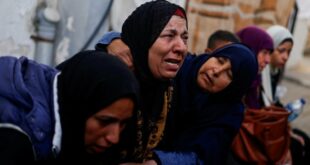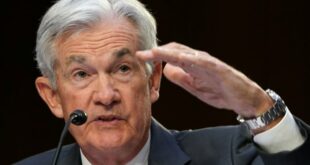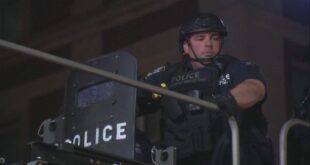Early optimism is being replaced by anxiety as politics threatens Ukraine's aid channels

"War," said British philosopher, mathematician and pacifist Bertrand Russell, "does not determine who is right — only who is left."
Those words might be the perfect lens through which to view what probably lies ahead for Ukraine in the coming year as its troops dig in — and dig deep — along a front roughly 960 kilometres wide.
Beyond that front stretches a wasteland of occupied territory — the smoldering ruins of a months-long summer counteroffensive that fell short of allies' hype and failed to dislodge the Russian Army from the 20 per cent of the country it occupies.
Behind it lies a war-weary population, growing domestic political anxiety and infighting, and international allies who have grown more capricious — even delinquent.
Whether it's aid roadblocks in the U.S. Congress, empty arsenal shelves in Canada or the political tantrums pitched by hostile leaders like Hungary's Viktor Orban, the war that captured the world's attention in 2022 has undeniably entered a dangerous new phase.
Dangerous — because solidarity among Ukraine's allies has started to fray, while the domestic political consensus in Ukraine itself shows signs of unravelling.
Ukraine's offensive has run out of road: expert
Ukraine's ability to conduct large-scale offensive operations "has ended," said Matthew Schmidt, an Eastern Europe expert at the University of New Haven, Connecticut.
"I don't think it is believed amongst the political leadership yet," he said. "It's not an accepted fact."
Ukrainian President Volodymyr Zelenskyy has tied his country's future — and his political future — to achieving the complete and total withdrawal of Russian troops from all of Ukraine, including Crimea, which Russia has occupied since 2014.
Gen. Valeriy Zaluzhnyi, commander in chief of the Ukrainian Armed Forces, penned a frank assessment of the battlefield conditions for the Economist last fall — one that contrasted with Zelenskyy's steadfast, optimistic public pronouncements.

Zaluzhnyi suggested the war was sliding toward a stalemate — a notion rejected by Zelenskyy even as the Ukrainian army began digging defensive positions along the line.
"Ukraine cannot continue to prosecute the war in the way that they have. It's that simple," said Schmidt, who estimated that without a new U.S. aid package, Ukraine's resources to prosecute the war could dry up as early as March.
Once it became clear to Russian President Vladimir Putin that he couldn't conquer all of Ukraine quickly, he switched to a strategy of grinding attrition, banking that the western solidarity which characterized the immediate post-invasion climate would crumble.
Putin seems to be counting on the attention deficit disorder that currently characterizes democracies in the West eating away at Ukraine's support, and may be hoping for the return of Ukraine-skeptic Donald Trump to the White House.

The far-right in the United States and Canada has characterized continued economic and military support for the government in Kyiv as a waste of money and resources — something Schmidt described as a lie of omission.
"They haven't told the full story," he said. "And the lie by omission that they've been telling has created the false impression that this is an unjustified sum of money … that no matter what the sum is, it's not helping American economic as well as security interest."
Phillip Karber, president of the conservative-leaning U.S.-based Potomac Foundation and an expert in Russian war strategy and tactics, said every Ukrainian soldier holding the line represents one American or Canadian soldier who does not have to be deployed to Europe.
"The Russians have tried various ways to interdict Western munitions" going into Ukraine, he said. Those efforts have not been "successful," he added, "but the U.S. Congress has done what the Russians couldn't."

On December 19, the Democratic and Republican leaders of the U.S. Senate said Washington will not be able to approve new aid for Ukraine before the year's end, as the two sides continue to seek a compromise over border security — unquestionably a domestic political issue.
Zelenskyy flew to Washington in mid-December to lobby for the aid. The Ukrainian president said at his year-end news conference that he remains hopeful that the United States "will not betray" his besieged nation.
Will Ukraine have to seek a ceasefire?
But given the developments of the last six months, both Karber and Schmidt said it's become much more likely that Ukraine will have to seek some kind of ceasefire or negotiated settlement in the coming year.
It's not hard to see why. While Russia's combat losses — estimated now at over 315,000 dead and wounded — have gotten all of the attention, the war has also bled the Ukrainian military both figuratively and literally.
It's believed that Ukraine has suffered up to 250,000 military casualties, with many of the wounded facing debilitating injuries.

More troubling still is the fact that Ukraine's military now faces an uphill recruiting battle.
In his essay, Zaluzhnyi acknowledged that training and recruiting troops was becoming a serious challenge. As late as December 18, the general was complaining publicly about Zelenskky's decision last summer to fire all of Ukraine's regional military recruitment heads in a corruption crackdown.
"The prolonged nature of the war, limited opportunities for the rotation of soldiers on the line of contact, gaps in legislation that seem to legally evade mobilization, significantly reduce the motivation of citizens to serve with the military," Zaluzhnyi wrote in The Economist.
Karber said there are key battles to keep an eye on in the coming months, chief among them Avdiivka in the eastern Donetsk region.
Holding the line in Donetsk
The Russians have poured tens of thousands of troops into a major offensive to take the city in the well-known coal mining region. As of December 21, they had advanced to within two kilometres of the city at an estimated cost of nearly 20,000 casualties.
Holding that part of the line is crucial to Ukraine's war effort, Karber said.
"If the Ukrainians get pushed off of their current positions that are holding, these guys are hooped," he said.
"The way the terrain opens up into flat country, if the Russians push through and break out into that area, it is basically open all the way to the Dnipro River (in the west) and north."
If the Russians try for a major breakthrough in the new year, Karber said, it likely will be in the late spring or early summer of 2024, when they've built up their depleted forces again.
In an intelligence assessment dated December 20, the U.K. Ministry of Defence noted that Ukraine had switched to a defensive posture along the line and had "mobilized efforts to improve its fortifications." The report said the likelihood of a Russian breakthrough at the time was minimal.
"The front is characterized by stasis," the assessment said.
Karber said the "horrific level of Russian casualties" is preventing major Russian gains.

He said Ukraine is likely to use a combination of long-range missiles, drones and special forces to turn parts of Crimea and the Kerch Strait and Black Sea regions into scorched-earth zones, with the aim of preventing Russia from resupplying and rebuilding its forces.
"The best hope is for Ukraine to get more long range missiles, ATACMS, to strangle Russian logistics," Karber said.
In October, Ukraine revealed it had quietly received, and then successfully used, American Army Tactical Missile System (ATACMS) long-range weapons against Russia.
Ukraine has said it needs more ATACMS weapons and vast quantities of ammunition, especially NATO standard 155 millimetre artillery rounds.
Fair-weather allies?
It is here that political machinations in the U.S. Congress and allied dithering — such as Canada's glacial progress on boosting ammunition production — have the potential to kneecap Ukraine, Karber said.
"Wars are won and lost on the margin," he said, referring to an army's ability to resupply itself. "And I hate to say it — [it's] embarrassing as an American, humiliating as an American — but we're the ones that hold that difference in that margin."
Allies like the United States and Canada tripped over themselves to give the Ukrainians 155 millimetre howitzers and modern main battle tanks, claiming the superior technology and firepower would help drive the Russians out.
But supplies of ammunition and spares for that equipment are now caught up in the funding fight in Washington.
"So it's a double whammy because we've introduced these systems, they're really important for the Ukrainians," Karber said. And now, with dwindling stocks of ammunition, their use is being dramatically scaled back.

Last fall, a CBC News investigation showed that high prices, corporate rivalries and a shortage of spare parts hobbled allies' efforts to help Ukraine repair the Leopard 2 main battle tanks it received from several countries.
The German manufacturers of the 55-tonne tank were reluctant to share the intellectual property rights so that a world-wide shortage of spare parts could be alleviated.
Russia may have sustained heavy losses, but its ability to absorb them and reconstitute its forces worries the experts.
"The Russians' ability at the moment [to resupply and rebuild key equipment] is potentially outstripping what the West is able to help supply Ukraine," said Dave Perry, president of the Canadian Global Affairs Institute, an Ottawa-based think-tank that occasionally hosts events sponsored by defence contractors.
Canada slow to resupply
Addressing the House of Commons defence committee in mid-December, Perry said he was particularly alarmed by the slow pace at which Canada was ramping up production of artillery shells.
Canada produces 3,000 of the 155 millimetre artillery shells per month under a framework called the Munitions Supply Program. It's a standing arrangement with five private sector companies — the most prominent being General Dynamics Ordnance and Tactical Systems Canada (GDOT-C) — to maintain stocks and provide surge capacity in times of crisis.
The federal government has been negotiating with the companies to boost production.
"I think it seems to me like there's been a lack of urgency and focus on this issue," Perry testified
"Notwithstanding the technical expertise involved in this, in the grand scheme of things, artillery shells are not complicated compared to air defence systems, or many of the other pieces of equipment that Ukraine needs."
ABOUT THE AUTHOR

Senior reporter, defence and security
Murray Brewster is senior defence writer for CBC News, based in Ottawa. He has covered the Canadian military and foreign policy from Parliament Hill for over a decade. Among other assignments, he spent a total of 15 months on the ground covering the Afghan war for The Canadian Press. Prior to that, he covered defence issues and politics for CP in Nova Scotia for 11 years and was bureau chief for Standard Broadcast News in Ottawa.
*****
Credit belongs to : www.cbc.ca
 MaharlikaNews | Canada Leading Online Filipino Newspaper Portal The No. 1 most engaged information website for Filipino – Canadian in Canada. MaharlikaNews.com received almost a quarter a million visitors in 2020.
MaharlikaNews | Canada Leading Online Filipino Newspaper Portal The No. 1 most engaged information website for Filipino – Canadian in Canada. MaharlikaNews.com received almost a quarter a million visitors in 2020.







